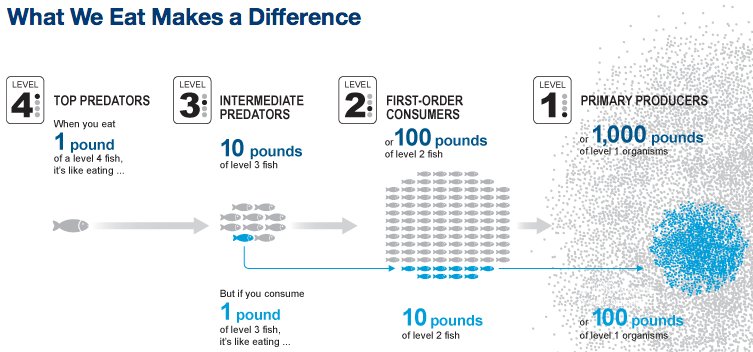Overfishing is a problem that is hitting all different kinds of marine species but not all marine species are equally at risk for becoming extinct. Different kinds of seafood are in higher demand then others and are being fished excessively. Instead of giving up seafood all together you should educate yourself on the types of fish that are most at danger and avoid them. Here is a guide to help you make less fishy decisions.
http://ocean.nationalgeographic.com/ocean/take-action/seafood-decision-guide/#/seafood-decision-guide/
Here is the "Seafood Decision Guide" National Geographic made this to show you the effect of the fish you are eating. It shows 75 different seafoods that are fished the most for commercial use. It shows the sustainability ranking which rates good or avoid. This is the measurement of the different impacts that farming or fishing have on the environment. Some of the factors that contribute to this our how they catch the fish, the species and the abundance of the fish. The second thing it tests is Omega-3 content if it is adequate or low. Omega-3 fatty acids (DHA+EPA) have been scientifically proven to have a large variety of health benefits. The nutrients found in these vitamins are found in a wide variety of seafoods. Some of the health benefits from taking these acids are helping brain development in children and prevention of heart disease in adults. The third is mercury level showing if it is moderate or high. Mercury is found in seawater in small amounts. It starts at the bottom of the seafood chain starting with algae. It is then eaten by other seafood so the amount of mercury increases every time a fish eats another fish. Large seafood such as sharks tend to have the highest levels of mercury in them because they live longer and are higher up on the food chain. Humans can get mercury poisoning from ingesting seafood with a large mercury content and women who are nursing or pregnant are encouraged to avoid seafood and if not eat seafoods low in mercury less then three times a week. The last thing they test the seafood on is food chain level. Every creature on earth is part of a food chain. In the ocean small creatures are eaten by larger species till you reach the top of the food chain such as shark and tuna. The higher the species is on the food chain the more food it takes for that fish to grow and live. When you eat a larger species you are consuming a larger amount of marine productivity.
This is how a bluefin tuna profile would look. Even though their high in Omega-3 content they are high in mercury as well and their sustainability level is said to avoid. They are also a top predator. This would be a perfect example of a seafood you would want to avoid if you cared about the issue of overfishing.
This is a farmed clam. They are low in mercury which would be a good seafood for a pregnant women or a person who wants to avoid fish high in mercury. The sustainability level is ranked best which means they have low environmental effects and are not at risk of going extinct. If you are against farmed seafood you could eat wild clams but they get a "Good" ranking not best like the farmed ones do.
This site also shows the premiere of a new show called "Cook-Wise" following chef and ocean conservationist Barton Seaver. He travels to all different fishing locations around the world and meets with different farmers and fishermen who are working to help end this global problem. He also shows healthy ways to cook the fish and tells you what fish to avoid completely. Catch it out!
http://ocean.nationalgeographic.com/ocean/cook-wise/




No comments:
Post a Comment